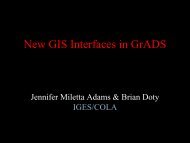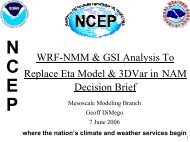The NCEP Climate Forecast System Reanalysis - NOAA National ...
The NCEP Climate Forecast System Reanalysis - NOAA National ...
The NCEP Climate Forecast System Reanalysis - NOAA National ...
Create successful ePaper yourself
Turn your PDF publications into a flip-book with our unique Google optimized e-Paper software.
CFSR-Lite for the TOVS period, but dramatically better in the ATOVS period, asuggestion that the higher resolution CFSR and GFS assimilation systems are exploitinginformation in the ATOVS systems not available from TOVS. Note that the NH and SHCFSR and GFS scores at the end of the period are nearly comparable, an indication thatthe medium range skill of the prediction of synoptic scale features is now comparableover oceans and continents.9.2 Atmospheric MassMonitoring atmospheric mass as part of a reanalysis effort is now common, seeFig. 10 in Uppala et al (2005) and Fig. 1 in Trenberth and Smith(2005), which comparedtraces of surface pressure, precipitable water and dry pressure in ERA40, ERA15 and R1.Compared to previous reanalyses, the new CFSR is very well behaved in terms of theatmospheric mass or, very nearly equivalent, the surface pressure. One sanity check is tostudy the time variation of the ‘dry pressure’, which should almost always be conserved.<strong>The</strong> dry component of surface pressure is defined locally by subtracting the precipitablewater (in all its forms) from the total surface pressure, converted to pressure units. Indeed,the global mean of dry pressure is almost constant, with a standard deviation of 0.10 hPaaround its mean value of 983.01 hPa over the 1979-present period (not shown). <strong>The</strong>global mean of the total pressure varies somewhat more, a standard deviation of 0.16 hPaaround its mean of 985.39 hPa, since the water content of the atmosphere is free to vary.However, even this variation is less than 1 hPa from maximum to minimum in the globalmean. In earlier reanalyses (Trenberth and Smith 2005), these variations were muchlarger and a consistency between total pressure and precipitable water was lacking.<strong>The</strong> mass balance of the atmospheric water component, with its input byevaporation (E) and output by precipitation (P), remains somewhat worrisome even in theCFSR. Global average monthly mean precipitation (P), evaporation (E) and E-P areshown in Figure 43. <strong>The</strong> global mean P is always larger than E (by a non-negligible fewtenths of a mm/day) and this imbalance grows around 1998, probably related to the ingestof new data systems, like AMSU. <strong>The</strong> decrease of global mean E-P after 1998 appears to- 46 -





